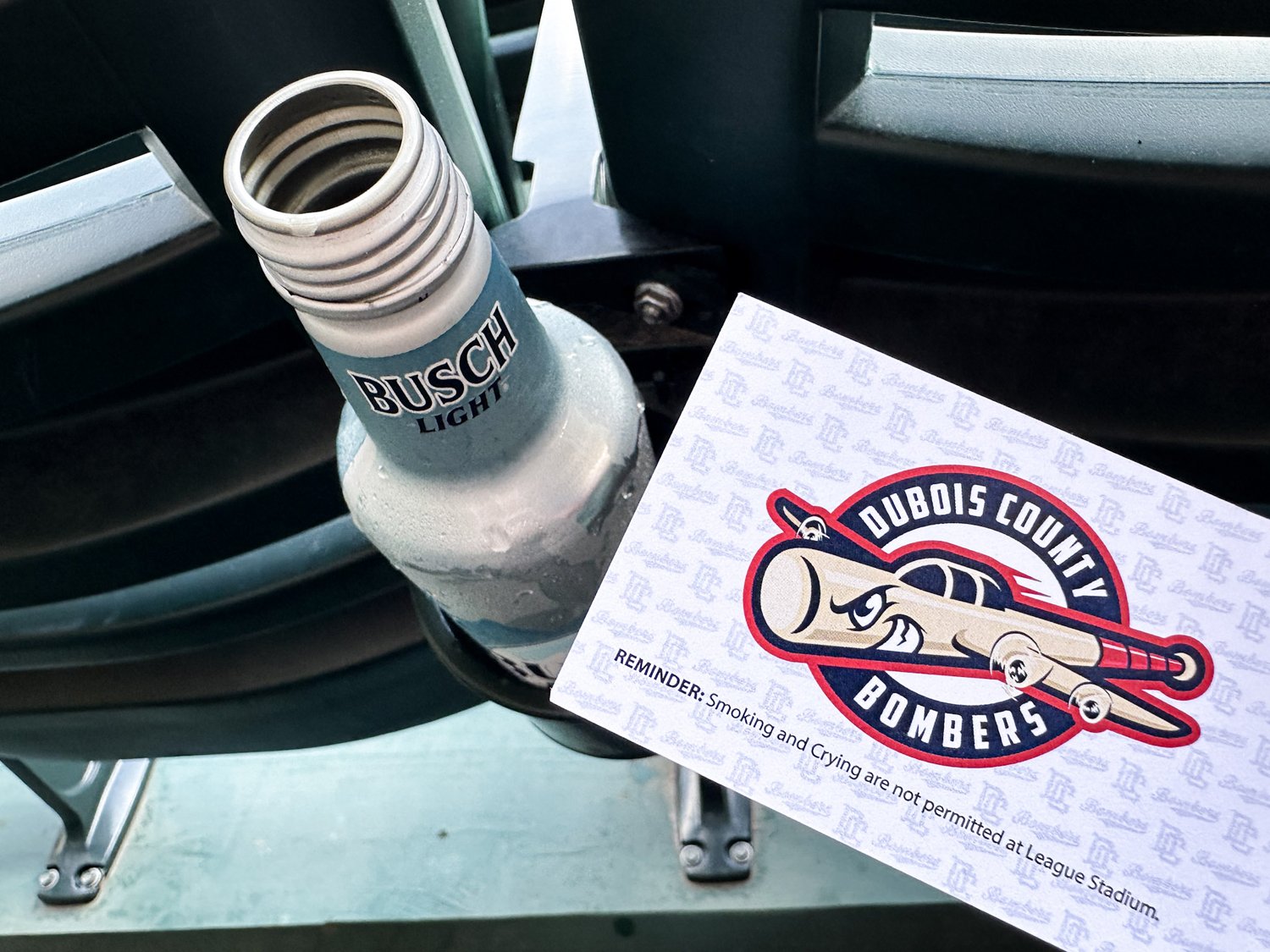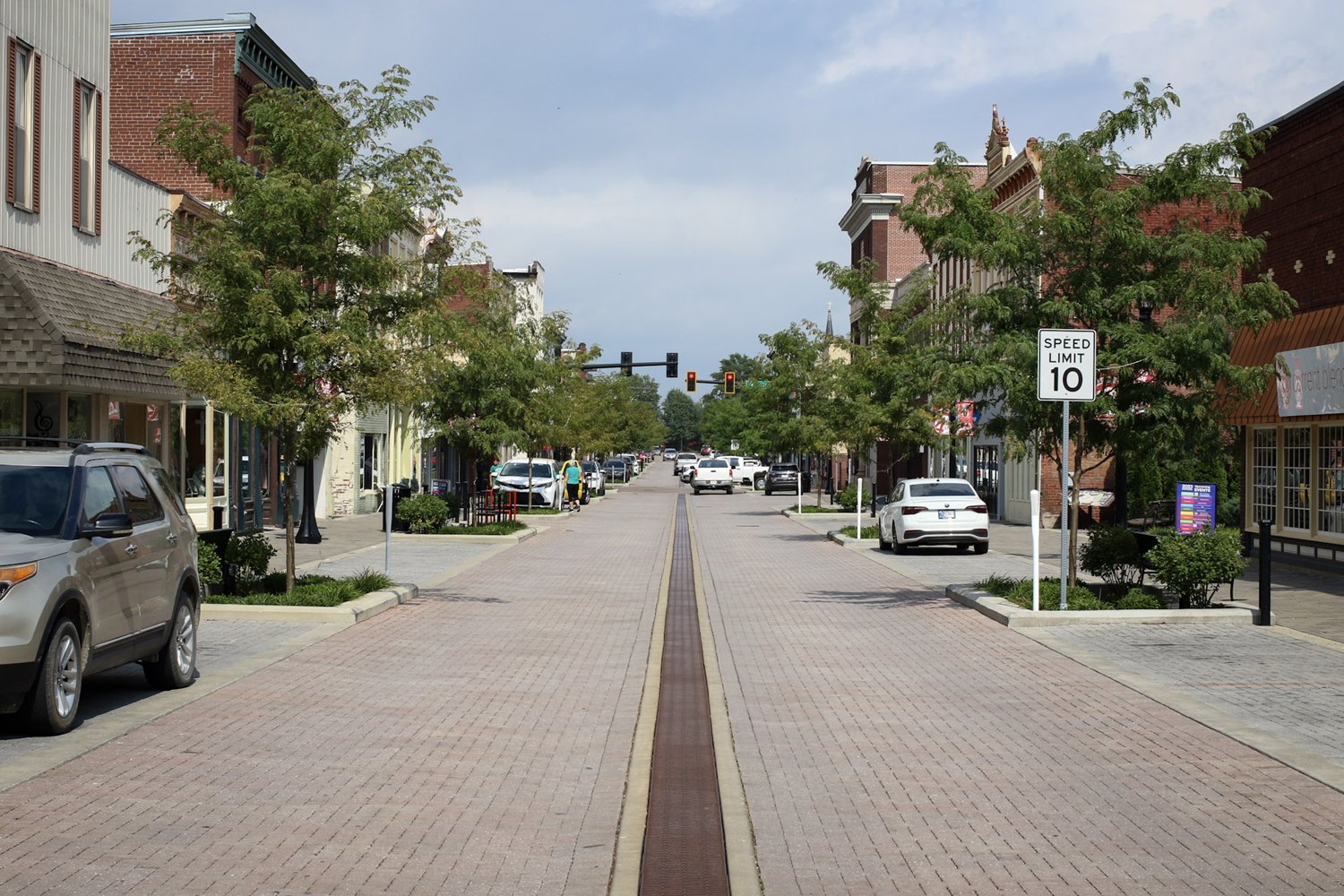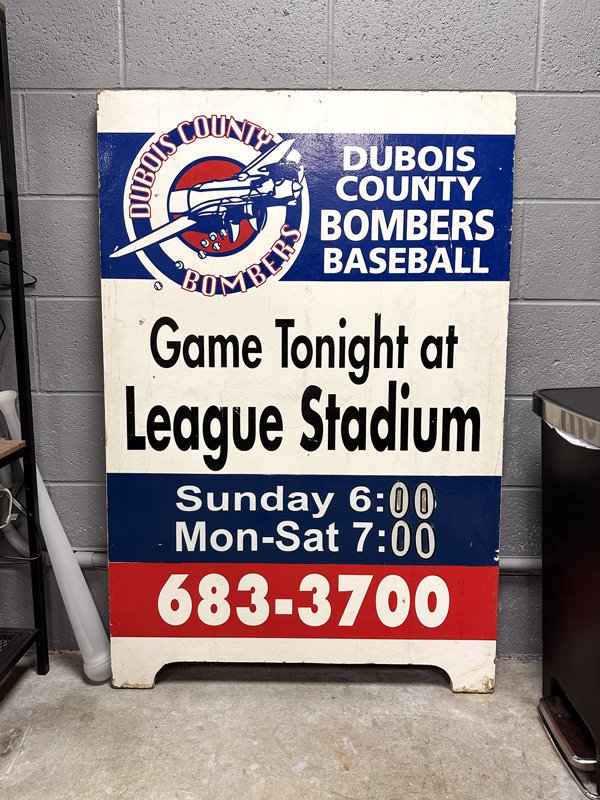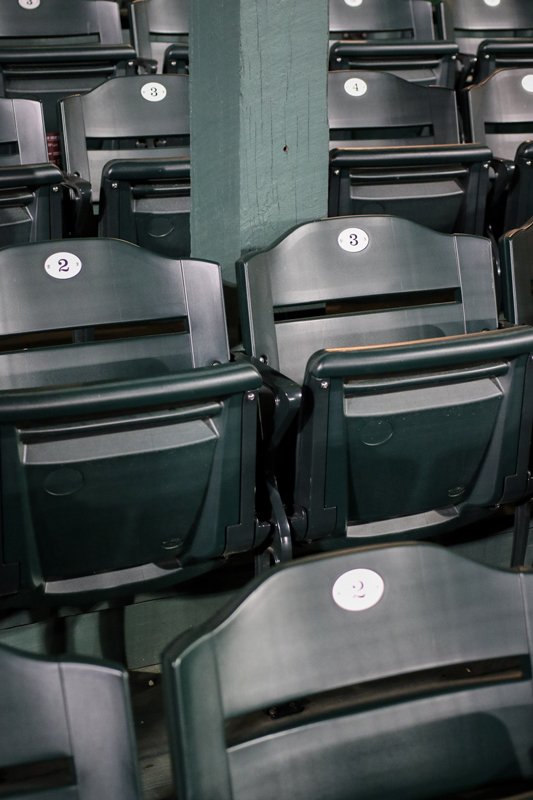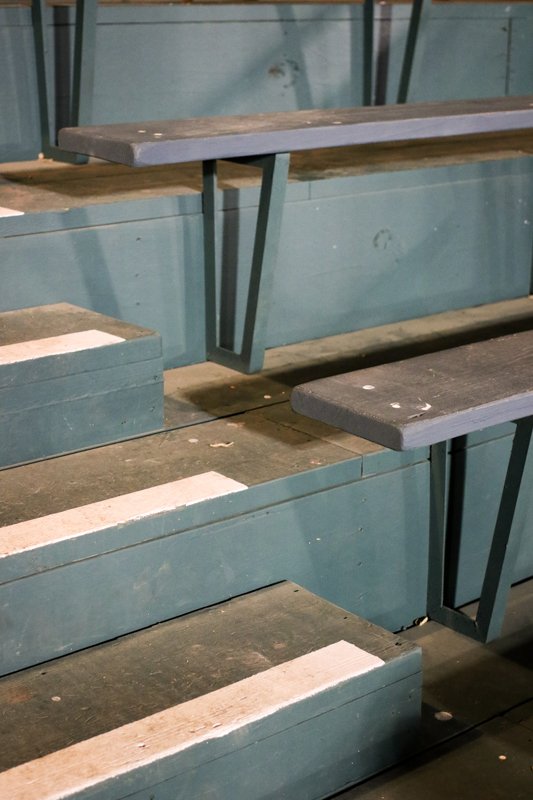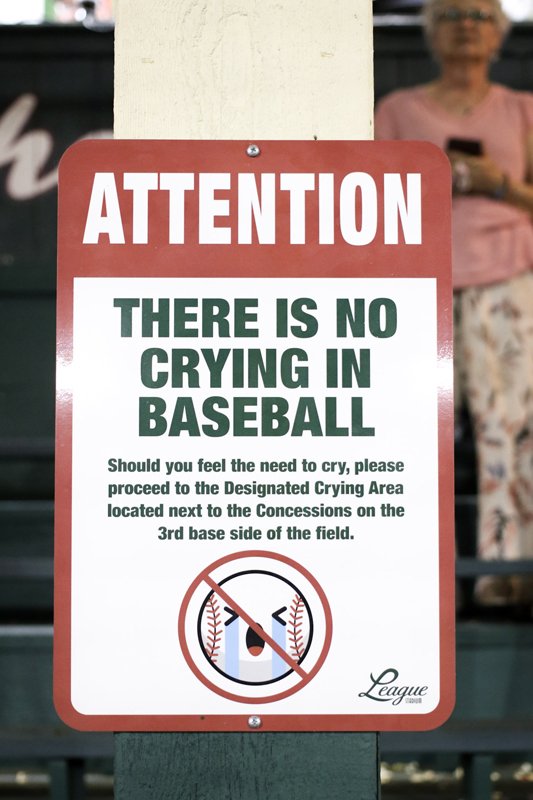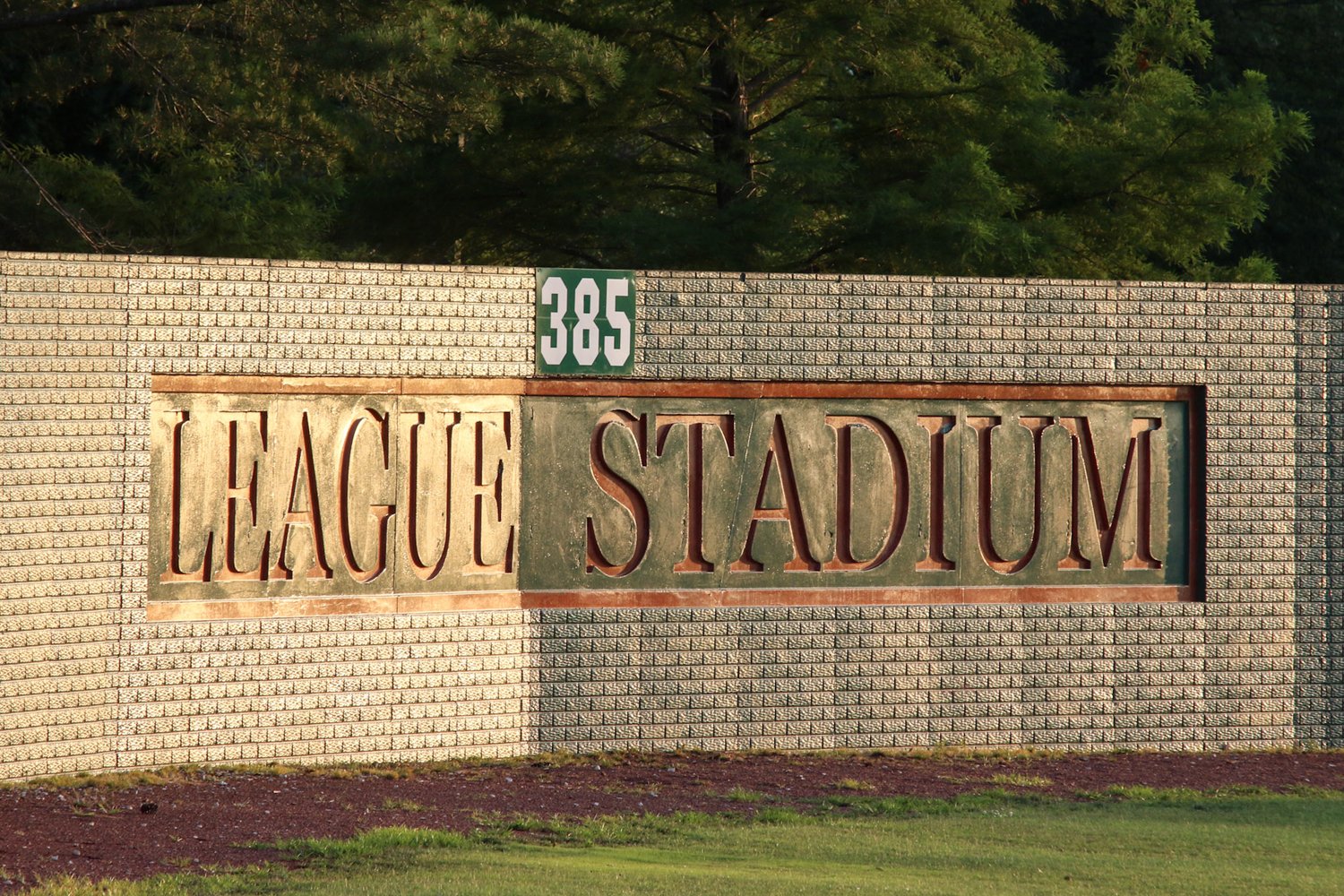League Stadium and the Dubois County Bombers
League Stadium in Huntingburg, Indiana during a Dubois County Bombers game against the Louisville Jockeys on July 20, 2023.
The ceiling fans seemed purely decorative—hardly moving any air and swirling so aggressively that you couldn’t make out the individual blades. The grandstand was covered at least, but jumping into the water next door would’ve felt heavenly. The public pool was the stadium’s lone neighbor in a community park located not far from the charming downtown. Publicly-owned assets bordered by an Indiana hallmark: a field of corn.
Despite the heat and humidity, though, I was perfectly content with a cold bottle of Busch Light, conversation, and the ball game playing out before us. Back home, I was just a few blocks walk from a major league park, but this 2.5 hour trek had absolutely been worth it. This ballpark oozed nostalgia. The kind that MLB suits fetishize, yet rarely emulate.
The sentimental environment of League Stadium was just a feature though, not the main attraction. That was the team. While there were a few between-inning gimmicks, the focus of everyone in the stands was squarely on the game. The fans knew all the player’s names, even if they’d only been competing there for a few months out of the summer before they’d head back to their regular lives. Hell, some of the season ticket holders had even opened up their homes to these kids. I say “kids” because that’s what they were. Technically adults who could be drafted into war, but most of them not old enough to legally drink, rent a car, or get paid to play pro ball. Yet.
Huntingburg, Indiana is the kind of town where the boulevard has signs warning that on-street parking is limited to two hours, but also one where that probably isn’t an issue. Not to say that the town is dead, rather, there’s so many houses and neighborhoods nearby that it seemed as if the majority of folks lived within walking distance. The kinds of people who supported local businesses like the brewery we stopped into. At four in the afternoon, it was already filling up. No one was sitting out on the patio in the heat, but they were packing inside for post-work drinks and dinner.
We’d grabbed seats at the bar, sauntering past the chain and poles that comically, and barely, separated our stools from the main dining room. A vestige of the state’s old-school alcohol laws that Jake told me about when we started our tabs. He certainly knew, Indiana was his home state. Even if he now lived in Cincinnati and loyally donned a Boston Red Sox cap everywhere he went (I don’t get it, either (I mean, I do, but I don’t support it (right color, wrong team))).
Jake was the reason we’d made the trip to Huntingburg. I think he first proposed the idea when we were drinking somewhere closer to home one night.
“My friend is part-owner of a baseball team in a small town in Indiana, you’d probably dig it,” he said…or….probably said.
That’s not a direct quote, but it was something like that. Enough for me to enthusiastically agree to head down from Ohio, through Kentucky, and over into Indiana one afternoon. At one point, Jake also mentioned that our destination was one of the ballparks where 1992’s A League of Their Own had been filmed. I hadn’t seen it, but I loved baseball and I trusted Jake. The guy had been a great friend, even if I had mistakingly thought his name was “Johnathan” for the first year we knew each other (long story). So, off to Huntingburg we went.
Eventually, we arrived in prime seats behind home plate and beneath ineffectual ceiling fans. That was after we’d been treated to wine slushees from the concession stand and before we got to climb onto the scoreboard in left field. All of this while the Dubois (pronounced locally as “dew boys”) County Bombers took on the Louisville Jockeys in a game that would determine home field advantage for the upcoming Ohio Valley League playoffs.
The slush-wine bar is named in tribute to the Rockford Peaches women’s baseball team from A League of their Own.
Most sources on the internet will tell you that League Stadium opened in 1894 before they all seemingly jump a century to the facility’s modern movie history. However, despite being a tourist attraction located within the United States’ “Hoosier State,” the best historical source on the internet comes from The Netherlands. According to the website, “Dutch Baseball Hangout:” League Stadium was initially constructed as a venue for the Dubois County Fair. After serving as a ballpark, as well as, a horse racing and livestock venue: storms destroyed the original grandstand in 1921. The facility would be rebuilt, continuing to serve as a home for both local baseball and the county fair, but time would take its toll. The fair would eventually relocate and the grandstand would fall into disrepair until Hollywood scouts picked it as a filming location for A League of Their Own.
The story goes that Columbia Pictures renovated and expanded the stadium in 1991 to suit the needs of the movie which starred Tom Hanks, Geena Davis, Lori Petty, Madonna, Rosie O’Donnell, and many others. In the 1992 film that opened to critical and commercial success, League Stadium serves as the home field of the Rockford Peaches women’s baseball team. Meanwhile, about an hour away in Evansville, Indiana, another classic ballpark known as Bosse Field served as the filming location for the movie’s climactic final game. League Stadium would see another movie filmed on its grounds in 1995 when crews arrived to shoot Soul of the Game for HBO.
A League of Their Own’s famous “there’s no crying in baseball scene” was filmed in League Stadium.
Screenshot from the HBO original movie, Soul of the Game, which featured League Stadium as a primary filming location.
The movie renovations allowed for Huntingburg’s wooden ballpark to attract a professional ball club. The Dubois County Dragons would debut as founding members of the independent Heartland League in 1996. Renovations would come to the facility once more in 1997 when relocated, plastic seats from the defunct Atlanta-Fulton County Stadium* were installed in the first few rows. All other seats in the ballpark remained as classic, wooden benches.
After the Heartland League collapsed, the Frontier League’s Parkersburg, WV franchise moved to Huntingburg and assumed the Dragons’ name. This allowed the city to keep independent, professional baseball for a few more seasons before that franchise departed** following the 2002 season.
A small museum beneath the grandstand highlight’s the facility’s movie history, as well as, its baseball history.
League Stadium wasn’t without baseball for long, however. While also serving as a venue for high school games, it eventually became home to the relocated Bluff City Bombers of the Central Illinois Collegiate League in 2005. The rebranded Dubois County Bombers have called Huntingburg home ever since, playing under various ownership groups in a variety of summer circuits. These days, the Bombers are members of the Ohio Valley League and field a roster of college athletes on summer break from both school and NCAA competition.
Jake’s friend, Barton Lewis, became a part-owner in the Dubois County Bombers a few years back. He welcomed us into the stadium, introduced us to the staff that makes Bombers games so wonderful, and told us about the history of the ball club when he wasn’t sharing his thoughts with the umpire. League Stadium is so intimate that the home plate official could definitely hear him and the other fans express themselves.
And we could all clearly see the missed calls.
League Stadium is owned by the City of Huntingburg and treated not just as a tourist attraction, but also as a community asset. In addition to the Bombers, the field also hosts the local Southridge High School Raiders. For the 2023 season, the facility received upgraded, new seats in its lower level that replaced the used ones from Atlanta. The Bombers have provided their own investments into the stadium as well. While providing the venue with a ball club and players, the organization has also built a branding identity that’s tied to the community and reflects their stadium’s historic charm. You’ll still find the wooden bench seats in the “upper deck,” but they’ve been complemented by classic murals, a retro color scheme, and modern beer stands.
The Bombers lean into the nostalgia of league stadium, but they don’t rely on it. Staff don uniforms reflecting the characters in A League of Their Own and the outfield wall still features a few classic advertisements installed for the film’s production, but the team has built their own legacy and the community has embraced the young players who come to town each summer. A situation described to us as one that “old guys will discuss over eight pots of coffee” in the spring before each season. Families seem to love the team as well. As I stood along the first base line making some photographs, the grandstand rail was lined with a huge group of kids watching the game and waiting for their chance to run the bases after it ended.
League Stadium’s left field wall still features iconography created for the filming of A League of Their Own. The murals are regularly touched up and maintained.
The Bombers have now firmly established themselves as a local staple and a point of pride. They’ve become a well regarded club within their league and a draw for college players looking to play outside of the school season. In addition to the community support, the team does what it can to provide and look out for its players. The camaraderie between the staff and the on-field talent was evident as we walked around the stadium before the first pitch. When we took our seats right before the game began, the period appropriate Jump Blues cut out and the overworked PA system roared to life. The first announcements weren’t for sponsorships, but rather, a thank-you to the fans for their support and then for a ceremony honoring the “Player of the Year.” An award named in honor of Devyn Newberry, a former Bomber who lost his life in a 2019 car accident. Newberry’s parents were on-hand to present the award to 2023 recipient, Joey Milto, and all received a standing ovation from the crowd occupying the iconic grandstand.
Towards the end of the game, with the Bombers on the verge of a rally, I stood near the press box and listened to the local radio announcer narrate the action. Even “up there,” the view was still great. A fitting ending to a wonderful day with baseball as the sun went down outside the right field corner. Unfortunately, the Bombers would lose the game and then eventually be eliminated from the playoffs. When the result was announced on Facebook, however, there wasn’t the usual social media sideline coaching complaints of missed calls, bad base running, or lack of hitting. Rather, the comment section was simply filled with fans sharing their memories and thanking the players for another great summer.
• • •
More information on the Dubois County Bombers, who are currently scouting and preparing for the 2024 season, can be found here.
Thanks:
Special thanks to Barton Lewis, as well as, the staff and players of the Dubois County Bombers for welcoming us into what became a personal highlight of this summer.
Also: a thank-you to Jake Moore who made a playlist for our road trip, but didn’t get to listen to any of it because I wouldn’t stop talking about random shit such as how great the McDonald’s we went to on the way home was. Thanks for being an awesome friend, Jake (and seriously, wasn’t that the best fucking McDonald’s you ever had?).
Related:
Other baseball work I’ve put together over the years:
• The abandoned Bush Stadium of Indianapolis
• The abandoned Cooper Stadium of Columbus
• Cincinnati and the 86th MLB All-Star Game
Footnotes:
* Atlanta-Fulton County Stadium opened in 1965 and lured the Milwaukee Braves of Major League Baseball to Atlanta for the 1966 season. It served as the Braves’ home for thirty years until after the 1996 Summer Olympics and 1996 World Series. Following the Olympics, the Braves moved to Turner Field —a retrofitted Centennial Olympic Stadium that had been designed with baseball in mind from the start. Atlanta-Fulton was then demolished. In 2017, The Braves moved to another new stadium in suburban Atlanta and Turner Field was renovated into a football stadium for Georgia State University.
** After leaving Huntingburg/Dubois County, the Dragons moved to Kenosha, Wisconsin and became the Kenosha Mammoths for one season. They then moved to Ozark, Missouri and became the Springfield-Ozark Ducks for another single season. Finally, the team moved once more and split its games between small communities in Ohio and Indiana as the Ohio Valley Redcoats. After one season of splitting ballparks, the franchise finally folded.
Since 2007, the content of this website (and its former life as Queen City Discovery) has been a huge labor of love.
If you’ve enjoyed stories like The Ghost Ship, abandoned amusement parks, the Cincinnati Subway, Fading Ads, or others over the years—might you consider showing some support for future projects?



